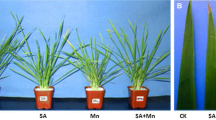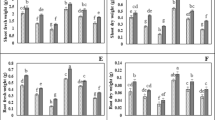Abstract
Responses of pea (Pisum sativum L.) seedlings to manganese (50, 100 and 250 μM) and indole acetic acid (10 and 100 μM) treatments were investigated. Single and combined exposure of pea to manganese and 100 μM indole acetic acid decreased root and shoot fresh mass, chlorophyll, carotenoids, protein and nitrogen while ammonium content increased compared to the control. Combined treatment of pea with 250 μM manganese and 100 μM indole acetic acid decreased root and shoot fresh mass by 54% and 51%, chlorophyll and carotenoids by 31% and 26%, root and shoot protein by 47% and 44%, and root and shoot nitrogen by 44% and 40%, respectively. Activities of glutamine synthetase and glutamate synthase were decreased by the exposure of manganese and 100 μM indole acetic acid while glutamate dehydrogenase activity increased. Combined application of 250 μM manganese and 100 μM indole acetic acid decreased root and shoot glutamine synthetase activity by 44% and 39%, and glutamate synthase activity by 39% and 37% while root and shoot glutamate dehydrogenase activity increased by 47% and 42%, respectively compared to the control. In contrast, application of 10 μM indole acetic acid together with manganese decreased the negative impacts of manganese, and promoted seedling growth compared to the manganese treatments alone. This study has shown that 10 μM indole acetic acid protected pea seedlings appreciably from manganese toxicity by regulating ammonium content and the activities of enzymes of ammonium assimilation, while 100 μM of indole acetic acid exhibited opposite response under manganese toxicity.



Similar content being viewed by others
References
Arditti J, Dunn A (1969) Environmental plant physiology–experiments in cellular and plant physiology. Holt, Rinehart and Winston Inc, New York
Arnon DI (1949) Copper enzymes in isolated chloroplasts. Polyphenoloxidase in Beta vulgaris. Plant Physiol 24:1–15
Balestrasse KB, Gallego SM, Tomaro ML (2006) Oxidation of the enzymes involved in ammonium assimilation plays an important role in the cadmium-induced toxicity in soybean plants. Plant Soil 284:187–194
Chakrabarti N, Mukherji S (2003) Effect of phytohormone pretreatment on nitrogen metabolism in Vigna radiata under salt stress. Biol Plant 46:63–66
de Melo MP, de Lima TM, Pithon-Curi TC, Curi R (2004) The mechanism of indole acetic acid cytotoxicity. Toxicol Lett 148:103–111
Deepali, Gangwar KK (2010) Metals concentration in textile and tannery effluents, associated soils and ground water. New York Sci J 3:82–89
Foy CD (1984) Physiological effects of hydrogen, aluminium, and manganese toxicities in acid soil. In: Adams F (ed) Soil acidity and liming, 2nd edn. ASA-CSSA-SSSA, WI, USA, Agronomy Monograph, pp 57–97
Gerendás J, Zhu Z, Bendixen R, Ratcliffe RG, Sattelmacher B (1997) Physiological and biochemical processes related to ammonium toxicity in higher plants. Plant Nutr Soil Sci 160:239–251
Ikan R (1969) Natural products, a laboratory guide. Academic Press, New York
Lang CA (1958) Simple microdetermination of Kjeldahl nitrogen in biological materials. Anal Chem 30:1692–1694
Lillo C (1984) Diurnal variations of nitrite reductase, glutamine synthetase, glutamate synthase, alanine amino transferase and aspartate amino transferase in barley leaves. Physiol Plant 61:214–218
Lowry OH, Rosebrough NJ, Farr AL, Randall RJ (1951) Protein measurement with the folin phenol reagent. J Biol Chem 193:265–275
Masclaux-Daubresse C, Reisdorf-Cren M, Pageau K, Lelandias M, Grandjean J, Valadier MH, Feraud M, Jouglet T, Suzuki A (2006) Glutamine synthetase-glutamate synthase pathway and glutamate dehydrogenase play distinct roles in the sink source nitrogen cycle in tobacco. Plant Physiol 140:444–456
Molins-Legua C, Meseguer-Lloret S, Moliner-Martinez Y, Campíns-Falcó P (2006) A guide for selecting the most appropriate method for ammonium determination in water analysis. Trends Anal Chem 25:282–290
Satyanarayana YV, Saraf R (2007) Iron and manganese contamination: sources, adverse effects and control methods. J Environ Sci Eng 49:333–336
Shi Q, Zhu Z (2008) Effect of exogenous salicylic acid on manganese toxicity, element contents and antioxidative system in cucumber. Environ Exp Bot 63:317–326
Singh RP, Srivastava HS (1983) Regulation of glutamate dehydrogenase activity by amino acids in maize seedlings. Physiol Plant 57:549–554
Singh RP, Srivastava HS (1986) Increase in glutamate synthase (NADH) activity in maize seedlings in response to nitrate and ammonium nitrogen. Physiol Plant 66:413–416
Skopelitis DS, Paranychianakis NV, Paschalidis KA (2006) Abiotic stress generates ROS that signal expression of anionic glutamate dehydrogenases to form glutamate for proline synthesis in tobacco and grapevine. Plant Cell 18:2767–2781
Wang H, Shan X, Wen B, Owens G, Fang J, Zhang S (2007) Effect of indole acetic acid on lead accumulation in maize (Zea mays L.) seedlings and relevant antioxidant response. Environ Exp Bot 61:246–253
Acknowledgments
We are grateful to The Head, Department of Plant Science, M.J.P. Rohilkhand University, Bareilly for providing necessary laboratory facilities to carry out this work. We wish to thank UGC, India for financial support.
Author information
Authors and Affiliations
Corresponding author
Rights and permissions
About this article
Cite this article
Gangwar, S., Singh, V.P. & Maurya, J.N. Responses of Pisum sativum L. to Exogenous Indole Acetic Acid Application Under Manganese Toxicity. Bull Environ Contam Toxicol 86, 605–609 (2011). https://doi.org/10.1007/s00128-011-0278-z
Received:
Accepted:
Published:
Issue Date:
DOI: https://doi.org/10.1007/s00128-011-0278-z




